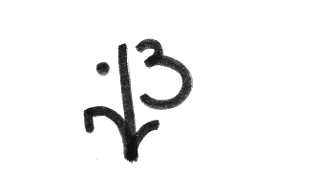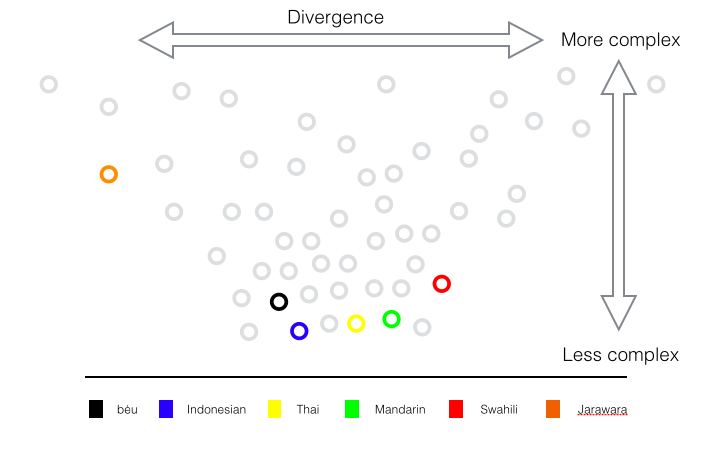Introduction to Béu: Difference between revisions
No edit summary |
No edit summary |
||
| Line 3: | Line 3: | ||
The language and culture of '''béu''' are listed in the 10 chapters that follow. At the moment only the first chapter can really be considered finished | The language and culture of '''béu''' are listed in the 10 chapters that follow. At the moment [22 Dec 2015] only the first chapter can really be considered finished. | ||
The cultural | The cultural information [chapters 7 and 8] seem to be pretty solid but the linguistic sections are still in flux. Hopefully in the not too distant future the language will become equally solid. | ||
.. | .. | ||
| Line 13: | Line 11: | ||
A history of the Language ... | A history of the Language ... | ||
The very first language that I tried to construct was called HARWENG. This was eventually given up about 14 years ago. The basic problem was that I didn't know enough about linguistics. | The very first language that I tried to construct was called HARWENG. This was eventually given up about 14 years ago. The basic problem was that I didn't know enough about linguistics. I layed down the basic linguistic rules of HARWENG, but when I tried to build upon these basics, what I build did not seem to stick together : it did not make a consistent whole, so reluctantly I put HARWENG aside. | ||
My second project was called SEUNA and this was also put aside after a number of years (I guess for similar reasons to why HARWENG was put aside). | |||
'''béu'''<sup>*</sup> is my third language and I have hopes of taking this one to fruition. | |||
<sup>*</sup>the diacritic above the "e" indicates that the word has a high tone. All words in this language I will indicate by bold type. From now on the only items in bold type will be elements and words from the language of '''béu'''. | |||
What interests me most in linguistics is the area where logic, grammar and semantics intersect. Also I very much appreciate the elegant patterns that are found in natural languages. I guess every natural language exhibits elegant patterns over part of their structure. | |||
However most natural languages also have elements which I don't like. It seems that the natural tendencies that forge a language also "limit" a language in a fundamental way : I find all natural languages insufficiently "efficient" and "elegant" for my taste : evolution by "decree" rather than natural forces just seems so much better. | |||
I have always been a perfectionist ... keenly aware of all the imperfections that everyday life entails. I have always had the feeling that in order to build perfection you must start at the very bottom ... and I also have had the feeling that language is the most basic thing<sup>*</sup> that makes us human. Hence the first step to making a better world is to develop a logical, elegant and beautiful language. | |||
All of the above motivated me to construct a new language. | All of the above motivated me to construct a new language. | ||
Revision as of 20:29, 21 December 2015
The language and culture of béu are listed in the 10 chapters that follow. At the moment [22 Dec 2015] only the first chapter can really be considered finished.
The cultural information [chapters 7 and 8] seem to be pretty solid but the linguistic sections are still in flux. Hopefully in the not too distant future the language will become equally solid.
..
A history of the Language ...
The very first language that I tried to construct was called HARWENG. This was eventually given up about 14 years ago. The basic problem was that I didn't know enough about linguistics. I layed down the basic linguistic rules of HARWENG, but when I tried to build upon these basics, what I build did not seem to stick together : it did not make a consistent whole, so reluctantly I put HARWENG aside.
My second project was called SEUNA and this was also put aside after a number of years (I guess for similar reasons to why HARWENG was put aside).
béu* is my third language and I have hopes of taking this one to fruition.
*the diacritic above the "e" indicates that the word has a high tone. All words in this language I will indicate by bold type. From now on the only items in bold type will be elements and words from the language of béu.
What interests me most in linguistics is the area where logic, grammar and semantics intersect. Also I very much appreciate the elegant patterns that are found in natural languages. I guess every natural language exhibits elegant patterns over part of their structure.
However most natural languages also have elements which I don't like. It seems that the natural tendencies that forge a language also "limit" a language in a fundamental way : I find all natural languages insufficiently "efficient" and "elegant" for my taste : evolution by "decree" rather than natural forces just seems so much better.
I have always been a perfectionist ... keenly aware of all the imperfections that everyday life entails. I have always had the feeling that in order to build perfection you must start at the very bottom ... and I also have had the feeling that language is the most basic thing* that makes us human. Hence the first step to making a better world is to develop a logical, elegant and beautiful language.
All of the above motivated me to construct a new language.
The best constructed language which I have so far come across was CEQLI. However it was not much more than a sketch. Also the two languages created by Dirk Elzinga ... TEPA and SHEMSPREG were also very neat. However again they were not fully thought out ... not complete languages. I intend that béu will be a fully formed language.
..
The "bubble fountain" above is how I see the world 4,000 languages (OK I haven't drawn 4,000 bubbles ... pretend) of the world. The vertical axis is complexity. The black line at the bottom represents zero ... the way that a group of people would communicate initially if they all spoke totally different languages and were forced to associate together by some twist of fate. There would be zero grammaticisation ... it would be a very inefficient means of communication and I would presume quite frustrating to try and converse in. The horizontal axis represents how far the different languages diverge from each other (this "divergence" should be multi-dimensional because of course languages diverge from each other in many many different ways ... but I am afraid we must make do with one dimension on my little chart).
You will notice that the simple languages at the bottom of the chart differ less from each other less than the more complex languages at the top. These simple languages tend to have one concept to one word ... they are analytic. Now a simple language is just as fit-for-purpose as a complicated language. And I certainly didn't want complexity for complexity's sake : I just wanted a language that was easy to learn and that would appear to be "natural". Hence the structure of béu is not a million miles away from the structure of English ... or Mandarin. In its final form béu seems like a natural language : the grammar and the "patterns" in the language wouldn't be considered out of place in a natural language.
In its long history (HARWENG => SEUNA => béu) it has changed many many times. It has gone thru' many iterations**. I would change one part of the grammar and then find that this change didn't fit with something else. So I would change it back, or modify the "something else", or maybe try out a completely new paradigm. This happened many many times. I suppose the changes that happened in in the development of béu are similar to the diachronic changes that happen to natural languages, and hence béu ended up looking quite naturalistic.
* I believe that language co-evolved with the increase in the human cranial capacity ... so language has been with us for well over a million years.
** A good analogy to this how a protein takes its shape. This is a long linear chain molecule that folds up on itself to takes on a very definite and complicated shape. The final shape is determined by a series of movements that are initiated by the attractive and repulsive forces that the various links in the chain have for each other. In a similar way the final shape of béu was determined by the way that different grammatical patterns and phonological patterns either clashed with each other, or matched with each other through a number of successive iteration.
..
Addendum ... When talking about grammar I follow the lead given by R.M.W. Dixon in "Basic Linguistic Theory". I would thoroughly recommend this book. As well as giving a broad topological perspective of the World's languages, it puts the convoluted terminology that has grown up in the field of linguistics over the years, firmly in its place.
..
Index
- Introduction to Béu
- Béu : Chapter 1 : The Sounds
- Béu : Chapter 2 : The Noun
- Béu : Chapter 3 : The Verb
- Béu : Chapter 4 : Adjective
- Béu : Chapter 5 : Questions
- Béu : Chapter 6 : Derivations
- Béu : Chapter 7 : Way of Life 1
- Béu : Chapter 8 : Way of life 2
- Béu : Chapter 9 : Word Building
- Béu : Chapter 10 : Gerund Phrase
- Béu : Discarded Stuff
- A statistical explanation for the counter-factual/past-tense conflation in conditional sentences

